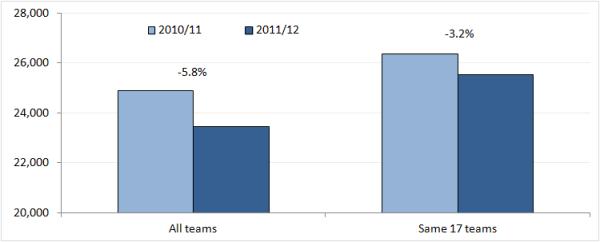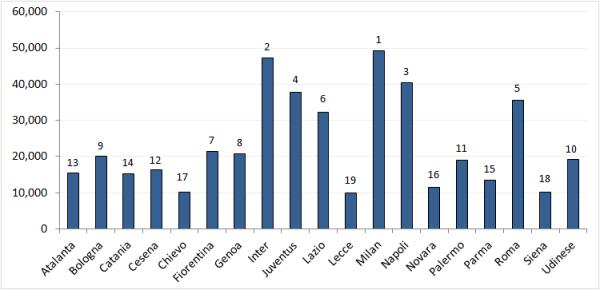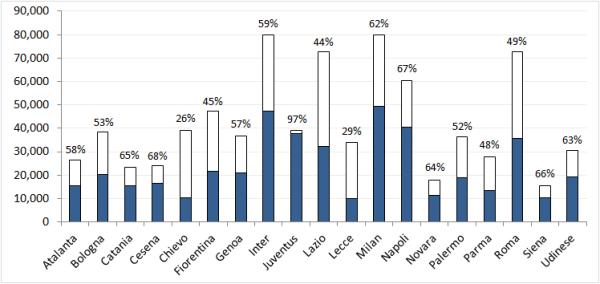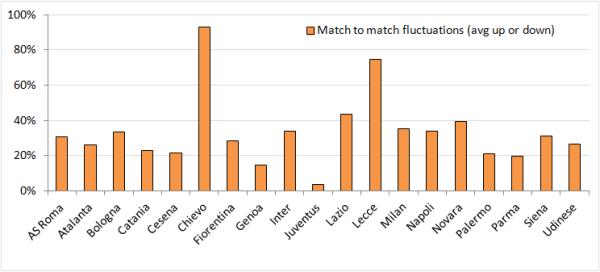
The Serie A is regularly getting painted as the sick child of European football. It is a league in decline, with betting scandals, crumbling stadiums, and ever declining attendances. Not a pretty picture, in fact, we have written about it ourselves too.
Whether exaggerated or not, it is a great context for analysing Italy’s attendances of last season.
We already know a few things from when we compared the Serie A with the other major European leagues. Most importantly, Serie A ranked fourth out of six with an average attendance of 22,756 per match.
We also know that the Serie A clubs managed to sell only 55% of all available seats, a lot lower than the Premier League and Bundesliga, but also than the Primera División and Ligue 1. Few matches sold out and due to the free capacity there was a lot of up and down movement in attendances.
Compiling Italian attendance data has not been an easy exercise, most of all because the attendances reported only count the tickets sold and do not include season tickets. This is something we can calculate though, but at times the numbers also seem outright dodgy.
That said, we have checked our figures with those of Fabrizio Pugi of the excellent stadiapostcards.com and are fairly confident that our numbers are reasonably accurate.
As always, we start with comparing the season’s average with that of the year before1:

Ouch, when we look at the full numbers we see a decline of almost 6% in the average attendance per match, which is a lot. However, it is fairer if we only compare the average of the clubs that actually participated in both seasons. Because the combination of Sampdoria, Bari, and Brescia had higher attendances than that of Atalanta, Novara, and Siena (thanks to Sampdoria mostly).
When we do this, we see that attendances actually declined with just over 3%, still quite a lot, but a lot less worrying than a decline of 6%.
The next graph shows how the individual clubs rank in attendance:

For years, Inter topped the table, but two dreadful seasons have finally had their impact on attendances and local rivals Milan have taken over the lead. They are followed by the usual suspects of Napoli, Juventus, Roma, and Lazio, after which there is quite a gap to the rest of the field.
There is a particularly big difference between the top and bottom clubs. Lecce failed to average 10,000 spectators a match, and Chievo and Siena barely did.
Some may find Cagliari missing in the overview, which is because they don’t publish attendance figures and what remains are very rough estimates. They would have ended up near the bottom though.
More interesting is, of course, how the above attendances compare with those of the previous season:

We see a lot of movement up and down. First of all, it becomes clear that Milan’s rise to the top of the table is not as much their achievement, but more so Inter tumbling down with a negative of over 20%.
We also see that Juventus’ attendances shot up spectacularly, which is, of course, because they moved to the brand new Juventus Stadium, which proved a massive success.
Lazio, Catania, and Udinese did particularly well, generally fuelled by good performances, while the poor seasons of Palermo, Fiorentina, Lecce and Genoa also showed. Napoli fell back after a very good season last year.
One of the big problems of Italian clubs is, of course, that they play in far too large stadiums. Which is illustrated in the following chart:

There is one exception, but none of the other clubs managed to fill 70% of their stadium. Lazio and Roma did not sell even half of all tickets, and San Siro was also much too big for the Milan clubs this season. Regardless of whether a club had high or low attendances, they all lived in a far too big home.
The exception is, of course, Juventus. Juventus’ attendances were far from spectacular in the 2010/11 season as they managed to sell only 85% of seats in the small Stadio Olimpico di Torino, but their move to the new Juventus Stadium has really done wonders for the club. Sure, their performance definitely sustained the momentum.
The notable thing Juventus did when they built the Juventus Stadium was to be modest. They resisted the temptation to build a prestigious arena, but instead settled on 40,000 seats. The result is that practically every match sold out, which in turn created further hype and demand.
Apart from Juventus, few matches sold out last season. What was particularly notable though, was that attendances turned out to be very volatile, moving rapidly up and down, and that most of this was caused by the opponent.
Most of Lecce’s attendances, for example, were below the 10,000, but over 23,000 people were attracted by the visit of Juventus. The same for Fiorentina, where most attendances were on or just below the 20,000, but 33,000 people came to Stadio Artemio Franchi to see Milan.
The following chart shows which clubs had the highest volatility in attendances, i.e., the most up and down movements from game to game.

We see that a lot of clubs had typical swings in attendances of 30% to 40% from game to game, which is a lot. Chievo and Lecce particularly suffered from low attendances that suddenly shot up when the big guns came to town.
The big challenge for the Serie A for the future is then to get the people that now only come to see the stars of Juventus and Inter to also to show up when Atalanta and Catania visit. And for this they need new stadiums, just like Juventus.
We have already written a whole article about this, but there is no harm in quickly rounding up the latest developments. The main conclusion is that there is a lot of talk, but no spades in the ground yet.
There is good news from Udine though, where Udinese recently saw plans approved for the redevelopment of Stadio Friuli. Roma and Inter also seem to be progressing steadily and hope to move into new stadiums around 2016.
Napoli’s plans seem to have somewhat stalled though, and Cagliari’s disaster is well-documented. They will move to the IS Arenas next season, a makeshift stadium in a nearby town, and hope to find a solution for the Karalis Arena in the next three years.
It has been very silent surrounding the plans of Catania, Fiorentina, and Palermo, and the likes of Atalanta and Chievo can only dream and pray at the moment.
So what can we expect of attendances in the next few years? Will the decline continue or has the moment come for a rebound?
Thing look rosy from one perspective though, and that is that the tree new boys, Sampdoria, Torino, and Pescara, will surely attract more spectators than relegated Lecce, Cesena, and Novara.
Juventus will likely keep selling out, but what happens with the rest is anyone’s guess. The attendances of the big clubs are particularly influential. If Inter’s attendances move up again to previous heights, things look good, but there is an equal chance that they will further decrease. The attendances of Milan, Napoli, and Roma can have a similar impact.
In terms of season tickets sold, it is a bit of a mixed bag so far. Some positive news (Roma, Sampdoria), some pretty neutral (Udinese), but also quite a few worrying reports (Milan, Palermo, Catania). But reports are still tentative.
Serie A will for sure be one of the more interesting leagues to follow next season if it come to attendances, but one hopes that there will be more pluses on the board this time next year.
Note 1: We earlier gave an average of 22,576 for last season, but have made some adjustments since (e.g. taking Cagliari out), which is why the number in the graph is slightly higher. All data for the 2010/11 season is from stadiapostcards.com.